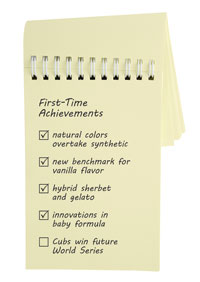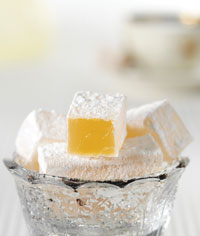A First Time for Everything
INGREDIENTS
There’s nothing new under the sun, some food cynics might argue. Well, that observation certainly doesn’t apply to this year’s exciting batch of emerging ingredient developments. Each one of these innovations can be described as a first-timer in some way. Perhaps it is because of their newfound regulatory status. Or because they are finding use for the first time in a brand new application. Or because they are relying on a new technology that provides the ingredients with benefits that had not been attained by other competing ingredients. Whatever the reason, they are breaking new ground and entering virgin territory for future ingredient formulation.
Hard to believe? Does it sound farfetched? Well, maybe some of the examples covered in this article will help convince you doubting Thomases. How about a range of vanilla flavors that may provide a new benchmark, helping to revolutionize the way the consumer perceives vanilla flavors? Or a groundbreaking salt ingredient that uses a technology that can turn standard salt crystals into free-flowing crystalline microspheres? Or a fish protein that may help block fat in fried seafood products? Or an improved approach to infant formula that has been designed to reflect the fact that the composition of breast milk changes significantly during lactation? Or a new technology that can literally listen to what the tongue feels, enabling formulators to predict the sensory effects of new foods.
Becoming convinced? Here are a few more examples to whet your appetite for the novel and innovative. For the first time, the value of natural colors has overtaken that of artificial colors in the global food market. You can bet new developments for natural colors are on the way as well. Take, for instance, a new emulsion technology that can combine multiple oil- and water-based natural colors to create new color shades. Or dissolvable bags that can deliver color into a food application.
And when it comes to their use in baby foods, these emerging developments may still be in their infancy, but they offer a great deal of potential from nutrition and functionality perspectives. Canola oil, blends of specialized milk protein fractions, oligofructose, and a new range of rice starches are just a few examples.
Proteins continue to find new applications, ranging from their use as bacteriocins to fat reducers to peptones, which are obtained from enzymatic or acid digestion of proteins from animal or plant sources. Other developments discussed in this article include a new antimicrobial approved for use in deli meats, a new candy concept that makes use of gelatin, whole-grain ingredients, and wine-making waste used as a dietary fiber.
These are just a few of the developments discussed in this year’s 15th installment of emerging ingredients, technologies, and applications. These novel, cutting-edge developments can help shape the parameters of how we traditionally view ingredients, the forms they take, the technologies that are used to produce them, the research studies that form their background and rationale, and, of course, the roles they play in delivering health and functionality to the consumer. As they break new ground in food formulation, these developments are truly first-timers.
Of course, a list of first-time developments will never be complete until the Chicago Cubs win a World Series. But until that happens, enjoy this list of emerging ingredient developments.
A Hybrid of Sherbet and Gelato?
At its 2013 Innovation Roadshow, David Michael & Co., Philadelphia, Pa. (www.dmflavors.com), highlighted several innovations. According to Victoria Vaynberger, Marketing & Consumer Insights Manager for the company, “One of the benchmarks of successful innovation is beating others to the punch. In our sector of the food industry, that often translates into being the first to present a new concept, rising flavor, or novel technological advancement.”
 This year David Michael showcased several products inspired by past roadshow innovations that have found retail success. For example, in 2007, the company exhibited its molten chocolate lava cookies, demonstrating how it overcame the challenge of transferring the molten center of a traditional lava cake into a handheld cookie. In the past six years, there have been numerous launches of similar products spanning both retail and restaurant realms, including Arby’s signature Chocolate Molten Lava Cake. At this year’s show, David Michael featured its chocolate lava cookies with raspberry flavor.
This year David Michael showcased several products inspired by past roadshow innovations that have found retail success. For example, in 2007, the company exhibited its molten chocolate lava cookies, demonstrating how it overcame the challenge of transferring the molten center of a traditional lava cake into a handheld cookie. In the past six years, there have been numerous launches of similar products spanning both retail and restaurant realms, including Arby’s signature Chocolate Molten Lava Cake. At this year’s show, David Michael featured its chocolate lava cookies with raspberry flavor.
In 2012, David Michael highlighted speculoos as a flavor to watch out for on the trend circuit. Originally from Belgium, speculoos cookies are characterized by their carmelized cinnamon and brown sugar notes. The cookies took off in Europe and eventually found their way stateside. Now speculoos flavor moved from the cookie format to applications ranging from chocolate to wine. Notably, David Michael featured speculoos flavor in ice cream.
In 2009, David Michael showed apple pie-filled, bite-sized pops forged on the trends of portion control, portability, convenience, and fun. Since then, a variety of dessert pops have surfaced at retail and in restaurants.
--- PAGE BREAK ---
Several of the products showcased at this year’s Innovation Roadshow have the potential to find their way to retail success. Here are just two examples.
What do you get when you cross a Buffalo wing with a potsticker? Something called “con-fusion”—the merging of continental U.S. cuisine with traditional ethnic fare. David Michael took the spicy, saucy goodness of the buffalo wing and enveloped it within traditional potsticker dough. To complete the experience, the potstickers can be dipped into a blue cheese sauce.
Or how about a hybrid of sherbet and gelato, a product that the company aptly calls Sherbato. Because of the neutral pH of the ice cream base, reaching the necessary acid levels to make a citrus flavor pop is not feasible as adding acid to ice cream denatures the protein, resulting in a thick, curdled, unappealing mess. Sherbet, on the other hand, is readily available in a variety of citrus flavors such as lime, lemon, and orange. This is because the low fat and low protein content of the sherbet base mix easily and welcome the addition of acid, resulting in a coarse, icy frozen dessert. When it comes to gelato, the fat content can vary within a range of zero to 18% fat, while the protein level is similar to that of ice cream. Gelato is usually intensely flavored and conducive to a neutral base; common flavors include chocolate, coffee, nut varietals, mocha, and caramel. Fruit-flavored gelatos include berries, stone fruit, and some tropical flavors.
The base mix has been formulated with a proprietary blend of stabilizers that allow for the addition of acid without denaturing the protein. Sherbato has half the fat of ice cream but has similar protein content. This results in a creamy and tart frozen dessert that welcomes the addition of acidic fruits and stands in a category all its own. David Michael displayed the product in three flavors—lemon, tangerine, and pink grapefruit.
To bring this new creation to retail, the mix would be processed by the manufacturer like any other ice cream mix. Added to that mix would be a flavor base that contains fruit, acid, sweetness, color, and flavor—similar to the preparations found in many yogurts. The finished product delivers a tart citrus fruit flavor traditionally found in sherbets, but retains the creamy texture and mouthfeel of gelato.
Natural Colors Overtake Synthetic Versions
For the first time, the value of natural colors has overtaken that of artificial colors in the global food color market. These were the findings of a new report from Mintel and Leatherhead Food Research.
In 2011, global sales of natural colors amounted to an estimated $600 million—up by almost 29% from 2007. The share of the total food colors market taken by natural varieties increased from 34% in 2007 to nearly 39% in 2011. In contrast, the artificial/synthetic color market is now worth an estimated $570 million, which is equivalent to 37% of the overall market (compared to 40% in 2007).
Furthermore, the use of natural colors in new food and beverage launches outweighs the use of artificial/synthetic colors by 2:1 on a global basis. Europe, in particular, has strongly moved toward the use of more natural colors and leads the way globally, using them in 85% of new product launches from 2009 to 2011.
The report predicts that the trend toward greater use of natural colors will continue, especially within premium food and drink segments and in products positioned for children.
A New Benchmark for Vanilla?
 A new range of vanilla flavors from Solvay Aroma Performance, Cranbury, N.J. (www.solvay.com), may revolutionize the way consumers taste and perceive vanilla notes in a variety of product categories.
A new range of vanilla flavors from Solvay Aroma Performance, Cranbury, N.J. (www.solvay.com), may revolutionize the way consumers taste and perceive vanilla notes in a variety of product categories.
Combining a rare intensity—up to 20% more intense than standard vanilla flavors—and a note that provides a long-lasting effect on the palate, Govanil™ vanilla flavors also significantly enrich a wide range of other flavors including butter, egg, biscuit, caramel, and fruit. Their vanilla taste characteristics allow these flavors to compensate for fat or sugar content in bakery and confectionery recipes.
According to Vincent Lajotte, Aroma Ingredients Business Director for the company, Govanil originates from all new proprietary and patented technology developed by Solvay and provides a whole new set of organoleptic and constituent properties. The line of flavors dramatically expands the range of possibilities for food applications. The new range was exhaustively researched and tested to meet consumers’ wide-ranging taste preferences. It already demonstrates outstanding results in cookies, petit beurre biscuit recipes, vanilla or chocolate fillings, and pastry creams.
Solvay developed three grades of flavors. Govanil, the benchmark vanilla flavor, offers a special and long-lasting character with value-added properties. Govanil Intense describes a grade ideal for doses below 0.1% and custom-made tastes. Govanil Natural allows for the use of “natural flavor” on food labeling. The range is continually developing and will be expanded to include other grades.
Salt-Reduction Microspheres
A new salt reduction ingredient, Soda-Lo™ salt microspheres, has been launched by Tate & Lyle, Hoffman Estates, Ill. (www.tateandlyle.com). The ingredient is created using a patent-pending technology that turns standard salt crystals into free-flowing crystalline microspheres. These smaller, lower-density crystals efficiently deliver salty taste by maximizing surface area relative to volume. Consequently, it is possible to enjoy the same salty taste while consuming lower levels of salt.
Because it is made from real salt, it has none of the bitter aftertastes or off-flavors associated with some other salt compounds or substitutes. With the ingredient, food manufacturers can reduce salt levels by 25% to 50% without sacrificing taste. It has been shown to work well in applications including baked goods, breadings and coatings, and salty snacks. Tate & Lyle licensed the ingredient from Eminate Ltd., a wholly owned subsidiary of The University of Nottingham in the United Kingdom. Under the license agreement, Tate & Lyle assumes responsibility for commercializing the salt-reduction technology on a global basis.
--- PAGE BREAK ---
New Antimicrobial Approved for Deli Meats
Liquid sodium propionate received U.S. Dept. of Agriculture approval, allowing it to be added to the list of approved antimicrobials for use in ready-to-eat meat and poultry products. As a result of the amended regulation, effective May 6, 2013, manufacturers of ready-to-eat meats and poultry can use the liquid antimicrobial BactoCease™ from Kemin Industries, Des Moines, Iowa (www.kemin.com), as an alternative to traditional lactates without an in-plant waiver.
Until now lactates have been the primary option for controlling Listeria monocytogenes in ready-to-eat meats and poultry. However, according to Kemin, research studies have shown that lactates perform inconsistently in controlling foodborne pathogens in deli meats.
“This is a game-changer for manufacturers of ready-to-eat meat and poultry products and consumers who value the quality and safety of these foods,” noted Chris Nelson, President and CEO of Kemin. The propionic acid-based antimicrobial system BactoCease offers a consistent, cost-effective alternative to help control Listeria monocytogenes, reduce microbial spoilage, extend shelf life, and increase the safety of ready-to-eat meat and poultry products. Multiple replications showed BactoCease consistently inhibited Listeria in turkey, ham, and roast beef for an average of 10–12 weeks.
Not only does BactoCease perform more consistently than traditional lactates, it has a lower application rate. This means lower ingredient cost per pound of meat produced without negatively impacting the sensory or quality attributes.
 Bactericidal Proteins That Attack With Precision
Bactericidal Proteins That Attack With Precision
Novel proteins can attack unwanted bacteria for improved food safety, quality, and shelf life. DuPont Nutrition & Health, Wilmington, Del. (www.dupont.com), through a collaboration with AvidBiotics Corp., will develop novel bactericidal protein technologies.
AvidBiotics antibacterial technology is based on R-type bacteriocins (proteins with bactericidal activity). These proteins recognize target bacteria by binding to specific receptors on the bacterial surface, then disrupting the cell envelope to kill the organism promptly. In theory, R-type bacteriocins can be developed against any pathogenic bacteria or spoilage organism of interest.
“A big advantage of the R-type bacteriocin technology for food applications is its specificity,” said James Knighton, President and Director of AvidBiotics. “Compared to antibiotics, which often kill beneficial and harmful bacteria alike, these proteins can be engineered to attack with precision. Just one protein can kill a targeted organism without affecting its neighbors, thus avoiding unintended collateral damage.”
Fabienne Saadane-Oaks, leader of the Health & Protection division of DuPont Nutrition & Health, noted, “Ensuring the safety, freshness, and quality of products throughout shelf life is at the top of the food industry agenda, and we are excited by the prospect of broadening our food protection by offering to help meet these challenges. Advanced applications that prevent the growth and survival of pathogens and undesirable organisms help to lessen the risk of foodborne illness and reduce the amount of food wasted every day due to spoilage. Investing in unique and novel technologies such as these is a great fit with the Food Security Goals recently announced by DuPont to improve the safety and quality of the global food supply.” Through its agreement with AvidBiotics, DuPont will gain exclusive worldwide rights to the technologies for food and food protection applications.
Peptone Now Available in the U.S.
Peptones are used as substrates for the growth of a wide variety of micro-organisms in processes developed by numerous industries involved in fermentation or cell culture including the biotech, pharmaceutical, and food industries. They are obtained from enzymatic or acid digestion of proteins from animal or plant sources and are the principal source of nitrogen in microbial culture media.
The Solabia Group proposes a new partnership in the sourcing of peptones to customers in the U.S. through the commercial services, customer support, and inventory of its subsidiary Solabia Inc., New York (www.solabia.com).
As Europe’s leading peptone manufacturer, Solabia specializes in peptone production and offers a complete (animal and non-animal) range of peptones for fermentation, diagnostics, or cell culture applications. For example, a wide range of plant peptones include potato, broad bean, pea, lupin, and several soy varieties. Multiple state-of-the-art manufacturing facilities allow separation of animal tissue and plant, providing security in supply.
The company also offers reliability in manufacturing and delivery, highlighted by significant production capacity, built-in redundancy, and the forward purchasing of strategic raw materials.
A Delightful New Candy Concept
A new candy concept developed by Netherlands-based Rousselot (www.rousselot.com), a leading producer of gelatin and collagen peptides, is described as a true confectionery innovation. Presented in small cubes and dusted with icing sugar, Rousselot Delights are comparable to Turkish Delights while providing some major advantages.
Turkish Delights are traditionally made with starch, but some recipes include gelatin. Also, the addition of citric acid gives these confections some elastic features. The new concept developed by Rousselot avoids the usage of starch and citric acid, and the resulting confections are innovatively firm and non-chewy. Furthermore, the texture can be easily modified by adjusting the pH and syrup qualities. The process used to make the new confection involves only gelatin and is two or three times shorter than the one used to make traditional Turkish Delights.
According to the company, the possibilities of natural and artificial flavors are almost unlimited with Rousselot Delights, and a large number of inclusions such as pistachios, chopped dates, and walnuts can also be used. Several prototypes have been showcased including those flavored with rosewater, cinnamon, orange blossom, and pistachio.
Compared to a traditional gummy, the new concept offers better heat resistance and can easily be stored in warm environments of up to 40°C to 45°C.
--- PAGE BREAK ---
Rubbing the Right Way
A new technology that records and analyzes the sound of the tongue rubbing against food can be used to predict the sensory effects of food innovations. Developed by Dutch researcher NIZO, the technology would enable food scientists to determine the creaminess or astringency of foods.
When formulating for low-fat or low-carb products, developers have to deal with a significant change in mouthfeel and need to compensate. Currently, standard rheology measurements are used to determine viscosity. More relevant is the way a product changes the friction of surfaces, and for this reason tribology is often attempted. However, the plastic or stainless steel surfaces used in tribometers cannot sufficiently mimic the soft, mucous-coated papillary surface of a live tongue.
A new technology, called “acoustic tribology,” records and analyzes the sound generated by rubbing or tapping of the tongue in the mouth during mastication. In other words, it is possible to listen to what the tongue feels. The inventor of this technology, George van Aken, explained that the sound is caused by the same vibrations of the tissue that are sensed by the mechanoreceptors in the tongue that signal the sensations of roughness, stickiness, and structural coarseness of any food (fluid, semi-solid, and solid). Acoustic tribology is noninvasive, measures in real time, and can be applied directly on human subjects without any preconditioning or preparation of body surfaces.
“The advantage of acoustic tribology is that we measure where the consumer experiences the food: in the mouth,” said van Aken. “It gives objective information about the suppleness of movements and thus the lubricating behavior of the food on the tongue.”
Emulsion Technology Creates New Natural Color Shades
New natural color shades that were previously unattainable can now be achieved by an advanced emulsion technology developed by Sensient Colors LLC, St. Louis, Mo. (www.sensientfoodcolors.com); the technology combines multiple oil- and water-based natural colors to provide a complete color matrix in a single delivery system.
 According to the company, the complex new water-based emulsions allow for oil- and water-based natural colors to coexist in a single color system. For instance, different vegetable juices and beta-carotene can be combined to make a bright, stable red shade, similar to carmine. This technology can lessen package staining, reduce color bleed, and allow for lower usage levels. It can also minimize off-taste flavors that are sometimes associated with natural colors. These water-based emulsions can be easily incorporated into any application where water is available. Since natural colors are often water-based, Sensient’s global research and development teams used the emulsion technology to develop new oil-based natural colors, fulfilling a market need for more shades that can be incorporated into fat-based systems. This includes shades such as cherry red, strawberry pink, and chocolate brown. Oil-based natural colors can be incorporated where oil is available, including icings, compound coatings, baked goods, and processed foods. Being a single color delivery system, the technology with both oil- and water-based emulsions can shorten measuring and mixing time, improving consistency and efficiency.
According to the company, the complex new water-based emulsions allow for oil- and water-based natural colors to coexist in a single color system. For instance, different vegetable juices and beta-carotene can be combined to make a bright, stable red shade, similar to carmine. This technology can lessen package staining, reduce color bleed, and allow for lower usage levels. It can also minimize off-taste flavors that are sometimes associated with natural colors. These water-based emulsions can be easily incorporated into any application where water is available. Since natural colors are often water-based, Sensient’s global research and development teams used the emulsion technology to develop new oil-based natural colors, fulfilling a market need for more shades that can be incorporated into fat-based systems. This includes shades such as cherry red, strawberry pink, and chocolate brown. Oil-based natural colors can be incorporated where oil is available, including icings, compound coatings, baked goods, and processed foods. Being a single color delivery system, the technology with both oil- and water-based emulsions can shorten measuring and mixing time, improving consistency and efficiency.
New Nutritional Oil
A high value, specialty nutritional oil for global consumer markets will be developed through a formal collaboration between DuPont Pioneer, Des Moines, Iowa (www.pioneer.com), and Arcadia Biosciences Inc., Davis, Calif. (www.arcadiabio.com).
Under the agreement, Arcadia, an agricultural company focused on developing technologies and products that benefit the environment and human health, will receive certain licenses to specific DuPont Pioneer innovations and intellectual property. The underlying focus of the collaboration will be to develop new safflower varieties that produce high levels of arachidonic acid-containing oil in a concentrated, reliable, and cost-effective way.
Blocking Fat in Fried Seafood
New research shows that fish protein could be the future of fat reduction in fried foods. Researchers at Oregon State University have been working on a project that drastically reduces the fat content in fried seafood using fish protein found in surimi.
“After doing some initial tests with typical fried U.S. products such as chicken nuggets and French fries, we saw that the fried surimi product was consistently low in fat,” said Jae Park, Professor in OSU’s Dept. of Food Science and Technology and OSU Seafood Research and Education Center, Astoria, Ore. “We thought if it’s the fish protein that is minimizing the fat uptake, how can we use that on other fried seafood to get the same results?” After two years of research, Park and his research team have developed a fat blocker solution from surimi protein that has successfully reduced the fat content of fried shrimp.
“Typically when you fry chicken nuggets or fish, you get a fat content of about 16% and 10%, respectively,” explained researcher Angee Hunt. “When we fried the breaded shrimp by coating it with our fat blocker solution, the treated shrimp had 15% to 20% less fat compared to untreated shrimp.”
The scientists believe that the fish protein creates a protective layer around the food to reduce the fat uptake and retain the moisture, without altering the taste or texture of the product.
Winemaking Waste as Dietary Fiber
Waste not, want not. That saying may apply here, as researchers at Oregon State University have discovered how to turn the pulp from crushed wine grapes into a natural preservative or a nutritional enhancement for baked goods.
The U.S. wine industry creates a large amount of waste from processing more than 4 million tons of grapes each year, mostly in the Pacific Northwest and California, according to the U.S. Dept. of Agriculture. Wineries typically pay for the pulp to be hauled away, but a small percentage is used in low-value products such as fertilizer and cow feed.
“We now know that pomace can be a sustainable source of material for a wide range of goods,” said researcher Yanyun Zhao, a professor and value-added food products specialist with the OSU Extension Service. “We foresee wineries selling their pomace rather than paying others to dispose of it. One industry’s trash can become another industry’s treasure.”
--- PAGE BREAK ---
The pulp, which consists of stems, skins, and seeds, is known as pomace and is packed with dietary fiber and phenolics, which have anti-oxidant effects. OSU researchers have dried and ground it to create edible and nonedible products.
For example, they extracted dietary fiber from pomace and turned it into powders that can be added to foods. Because the phenolics in pomace also control microbial growth and keep fats from deteriorating, OSU researchers have added the powdery fiber to yogurt and salad dressings to extend their shelf life by up to a week without changing taste and texture.
The researchers also used pomace to make colorful, edible coatings and films that can be stretched over fruits, vegetables, and other food products. They contain antioxidants, seal in moisture, and control the growth of some bacteria.
Additionally, the scientists added pomace powders, which are gluten-free, to muffins and brownies. They replaced up to 15% of the flour in the recipes with it and thus increased the fiber and antioxidants in the baked goods. The research continues as scientists are also adding pomace to yeast breads.
Researchers found that the methods for making products from pomace vary depending on whether the pulp is derived from red or white grapes. That’s because wine-making processes differ for each varietal, and they produce pulp with different levels of sugar, nitrogen, phenolics, and other compounds.
Stevia Improver Reduces Licorice Aftertaste
A natural, plant-derived technology is said to reduce the licorice profile of stevia, bringing it closer to that of sugar. Switzerland-based Natural Taste Consulting (www.ntcflavors.com) developed and commercialized the special technology.
After studying the structure of the glycoside, Natural Taste Consulting identified a plant-derived substance that could compete with the “steviol tail” and reduce the perceived licorice profile. The company claims that the use of its “discovery” will provide the product developer the possibility to increase the current use of stevia extract to further reduce caloric sweeteners without the undesired aftertastes. Furthermore, in tests carried out in existing foods and beverages enriched with stevia, the sweet profile was brought closer to sugar and significantly increased consumer preference. Natural Taste Consulting claims that its natural stevia improver is heat stable, kosher, and very cost effective. It can be labeled as a natural flavor.
Designing the ‘Perfect’ Bubble
Scientists at the Nestlé Research Center in Switzerland are using zero gravity research to develop their understanding of the foam technology used in its products. Nestlé is working with the European Space Agency on foam experiments designed to produce the “perfect” bubble. Bubbles are added to products such as chocolate mousse and coffee froth to make the right texture or consistency.
Before the parabolic flights, Nestlé scientists placed six 5-mL samples of water and milk protein in a special machine that analyzes the structure of foam. These were carried onboard the European Space Agency-sponsored A300 airbus plane. Flying at a maximum height of 28,000 ft, the plane made about 30 “parabolas,” or up and down dips, creating zero gravity or weightlessness. During those short periods, the researchers studied the milk protein to see if it makes foam and how stable the bubbles are. The stability of the bubbles determines the shelf life of a number of products and is key to the consumer’s taste experience. Foam is easier to study under zero gravity conditions because weightlessness causes bubbles to be evenly dispersed rather than floating to the top.
 Dissolvable Color Bags Offer New Delivery Solution
Dissolvable Color Bags Offer New Delivery Solution
A new delivery system in the form of dissolvable color bags has been launched by Sensient Colors, St. Louis, Mo. (www.sensientfoodcolors.com). The development is described as the first dissolvable bag in the food color industry.
According to the company, AccuPak water-soluble bags are a convenient packaging alternative that deliver the proper dose of color and eliminate dust and cross-contamination issues. The custom pack sizes are preweighed to ensure accuracy and provide batch-to-batch color consistency. The quick-dissolve bags eliminate messy cleanup and are a sustainable solution by reducing packaging waste. The bags can be used in a variety of color applications including beverage, dairy, bakery, and processed foods.
Fats May Impact Taste Perception
A study published in Chemosensory Perception shows that fats in food may activate certain regions of the brain, thereby influencing how flavors are perceived.
The researchers aimed to determine how the brain responds to changes in the fat content of four different fruit emulsions participants tasted. The researchers used a magnetic resonance imaging scanner to view the participants’ brain activity upon tasting the emulsions. All samples were of the same thickness and sweetness, but one contained flavor with no fat, while the others contained fat with different flavor release properties.
The researchers discovered that when the nonfatty sample was tasted, the somatisensory cortices and the anterior, mid, and posterior insula (regions that control perception of flavor) were significantly activated more than when the fatty emulsions were tasted, even though they had the same flavor perception. They noted, however, that increased activation in these regions doesn’t necessarily mean that flavor perception is increased.
“This is the first brain study to assess the effect of fat on the processing of flavor perception, and it raises questions as to why fat emulsions suppress the cortical response in brain areas linked to the processing of flavor and reward. It also remains to be determined what the implications of this suppressive effect are on feelings of hunger, satiety, and reward,” concluded study author Joanne Hort, Associate Professor of Sensory Science at the University of Nottingham.
A New Arsenal of Whole Grains?
Emerging developments are also occurring in the area of grains, especially whole grains, as can be seen during any recent visit to McDonald’s. The fast-food chain recently decided to use bakery-style buns with whole grains and English muffins with whole grains.
Whole grain ingredient innovations are expected to continue, with ConAgra Foods responsible for several of them. Take, for example, ConAgra Mills, Omaha, Neb. (www.conagra.com), which is offering increased multigrain, gluten-free, and textural options. Since its introduction in 2007, the ConAgra Mills’ Ancient Grains line of amaranth, quinoa, sorghum, millet, and teff—as well as custom multigrain and gluten-free blends—has quickly grown in popularity, finding use in a broad range of applications. Now ConAgra Mills is expanding its line of Ancient Grains by adding buckwheat, spelt, and a variety of puffed and toasted grains for whole-grain, multigrain, gluten-free, and artisan foods. The expanded product line is available in whole-grain flours, whole seeds, toasted grains, puffed grains, and custom multigrain blends in traditional, gluten-free, and organic options.
Earlier this year, ConAgra Mills expanded its Ultragrain® milling capacity to better accommodate retail food companies and foodservice operators that are partially replacing traditional white flour with the company’s whole wheat flour.
Also, a new flour milling company, Ardent Mills, has been formed by ConAgra Mills and Horizon Milling (a Cargill-CHS joint venture created in 2002). The new company will take advantage of the combined assets, capabilities, and experience of ConAgra Foods, Cargill, and CHS to bring innovative flour and grain products, services, and solutions to the marketplace.
--- PAGE BREAK ---
Collaboration Identifies Salt Alternatives
A collaboration between Nestlé and a U.S. life sciences company, Chromocell Corp., will identify compounds that may be used as alternatives to salt. Chromocell, which is based in New Jersey, will use its proprietary “Chromovert” technology to screen libraries of ingredients to detect those that provide similar or equally pleasing tastes to those that salt provides. It is hoped that the technique, which enables researchers to screen a wide selection of compounds, will lead to the discovery of new flavors.
Nestlé is investing $15 million in the research as part of its worldwide commitment to improve the nutritional profile of its products while ensuring they remain pleasurable to eat. Chromocell identifies and develops new food and beverage ingredients, as well as ingredients for therapeutic purposes. To do so, Chromocell uses naturally occurring systems that mimic human biology.
Without the Pioneers, Where Would We Be?
Well, that brings us to the close of another installment of emerging ingredient developments. As I have noted in previous articles, I have always enjoyed these particular developments because of the optimistic spirit that is reflected in them. True, maybe not all of them will succeed in the marketplace or lead to advancements in future food formulating, but they all have the potential to do so. And without these developments, and the pioneers who make them possible, the food industry would truly stagnate. And remember, as these developments have shown, there is a first time for everything.
Next month’s Ingredients section will “reimagine fruits,” exploring new fruit ingredients and fruits from around the world.
Developments in Their Infancy
Several emerging developments are finding particular use in infant formula or jarred baby foods. One might say that these developments, while themselves not “babes in the woods,” are still in their infancy when it comes to their use for this market segment. Here are some examples.
• Formula staging. The $11.5 billion global infant formula category is reportedly set for its biggest innovation push in years following the launch of a radical new “staging” concept by Denmark-based Arla Foods Ingredients (www.arlafoodsingredients.com). According to the company, staging is an improved approach to infant formula designed to reflect the fact that the composition of breast milk changes significantly during lactation.
At present, the diet of formula-fed babies does not take account of this; these babies are usually given a “static” diet during their first six months. However, Arla Foods Ingredients has identified that the protein content of breast milk is dynamic and changes constantly during this period. In response, the company has developed blends of specialized milk protein fractions that will help manufacturers create formulas that mimic the changing nutritional profile of milk more closely during this short—but critical—time in a baby’s development.
Pernille Hostrup, Business Development Manager for Arla Foods Ingredients, noted, “ Our new staging approach means infant formulas can provide the right nutrients in the right quantities at the right time, to suit precisely a baby’s natural growth and development patterns during its first months of life. Human milk will always be the gold-standard for infant nutrition, but staging means formula-fed infants can now enjoy more of the long-term health benefits experienced by their breast-fed counterparts.”
At the heart of the staging concept is a range of Lacprodan® milk protein fractions developed by the company that can be blended in varying proportions to create staged infant formulas that mimic the nutritional profile of breast milk more closely.
Extracted from high quality whey proteins, Lacprodan ingredients provide the ideal amino acid profile to meet the needs of developing infants. This means formula manufacturers can reduce the overall quantity of protein in their products to levels closer to those found in breast milk, but still provide all the nutrients formula-fed infants need to develop healthfully and grow at a similar rate to breast-fed infants.
• New canola oil application. Canola oil is now generally recognized as safe for use as an ingredient in infant formula marketed in the United States. The U.S. Food and Drug Administration recently made public that it has no questions in response to a notice that was filed with the agency for the inclusion of canola oil as a source of fat in infant formulas. Canola oil can be used at levels up to 31% of the total fat blend.
“This is significant as canola oil has not previously been used in infant formula in the U.S. due to the absence of a GRAS submission to do so,” said Shaunda Durance-Tod, Manager of the CanolaInfo program at the Canola Council of Canada. “Canola oil is still a relative newcomer to the marketplace.”
All infant formula marketed in the U.S. must meet federal nutrient requirements. According to FDA, formulas must contain the essential fatty acids linoleic acid (LA) and alpha linolenic acid (ALA). Canola oil has among the highest ALA content of all edible oils—11% compared to 8% in soybean oil.
When used in combination with other oils that contain LA, canola oil can be used by infant formula manufacturers to target appropriate levels of LA (8–35% of total fatty acids) and ALA (1.75–4% of total fatty acids) and ensure the fat blend is within the recommended ratio of LA:ALA between 6:1 and 16:1.
“Canola oil has a lower LA:ALA ratio than other commonly used oils,” noted Durance-Tod. “In addition, canola oil is widely available at an affordable price. It is now number two by volume in the U.S.”
• Oligofructose in formula. FDA recently cleared the way regarding the safe use of Orafti® P95 (oligofructose) in milk-based term infant formula at a maximum level of 3 g/L as consumed. The agency agreed with the Generally Recognized As Safe determination jointly submitted by Pfizer Nutrition and BENEO.
Orafti P95, manufactured by BENEO (www.beneo.com), is a soluble dietary fiber. It is commonly referred to as oligofructose, a fructan derived from the chicory root plant. Fructans are well known for both prebiotic and fiber effects. Its ingestion can provide a prebiotic effect by selectively stimulating the growth of natural beneficial gut microflora. It can also act as a fiber, resulting in a softer stool consistency.
“This FDA letter of no questions for the use of Orafti P95 in the sensitive population group, infants, is an important step forward,” said Anke Sentko, Vice President Regulatory Affairs & Nutrition Communication at BENEO. “This will further contribute to the confidence in the safe use of this ingredient in infant formulas worldwide.”
• Fat blend for formula. A new study published in the Journal of Pediatric Gastroenterology and Nutrition demonstrates for the first time that InFat, a high palmitate fat blend, provides beneficial effects for the health and well-being of formula-fed infants. This double-blind, randomized, multicenter study shows a significant increase in Lactobacilli and Bifidobacteria abundance in the microbiota, shifting the flora composition to be more comparable to breast-fed infants.
InFat is a patented, clinically proven fat blend (beta-palmitate structured lipids) for infant formula with a high percentage of palmitic acid in its sn-2 position. This mimics the special composition of human milk fat, which is highly conserved in all women’s breast milk and thereby enables optimized uptake of calcium and energy as well as easy digestion. Recently, the ingredient has been shown to benefit bone strength parameters in term infants after 12 weeks of feeding.
The fat blend was developed by Advanced Lipids, a joint venture between Sweden-based AAK and Israel-based Enzymotec. The study, which was sponsored by Enzymotec, was conducted at the neonatology departments of Bnai Zion Medical Center, Haifa, Israel, and Meir Medical Center, Kfar Saba, Israel.
• Rice starches for baby foods. A range of rice starches from BENEO (www.beneo.com) offers a wide variety of nutritional and technical benefits for use in jarred baby food products. The rice derivatives can function as hypoallergenic texturizers to improve the mouthfeel, shelf life, and structure of food products. Test trials have shown that vegetable and fruit jarred baby foods made with the rice starch have improved product stability in terms of viscosity, syneresis control, and shelf life. In addition, the ingredient’s small particle size creates a creamy texture without any effect on the end product’s taste or color. Rice is highly digestible and consequently well suited for baby food applications.
www.ift.org
Members Only: Read more about emerging ingredients online at www.ift.org. Type the keyword into our search box at the upper right side of our home page.
 Donald E. Pszczola,
Donald E. Pszczola,
Senior Editor
[email protected]


